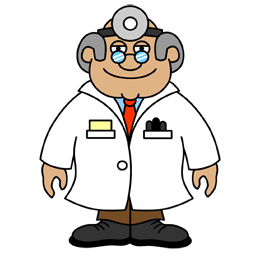Definition:
* Pain or discomfort located between the bottom of the rib cage and the groin crease.
* The older child complains of a stomachache.
* The younger child should at least point to or hold the abdomen.
Causes:
* Indigestion: Indigestion or overeating causes many mild stomachaches.
* Gastroenteritis: A viral infection of the intestines causes stomach cramps as well as vomiting or diarrhea.
* Food Poisoning: Severe vomiting or diarrhea lasting fewer than 12 hours is often caused by bacterial overgrowth in unrefrigerated foods.
* Constipation: The need to pass a stool causes lower abdominal cramps.
* Strep: Strep throat causes up to 10% of acute abdominal pain.
* Serious Causes: These include appendicitis, kidney infections, and intussusception. Suspect appendicitis if pain is low on the right side, the child walks bent over, the child won’t hop or jump, and the child prefers to lie still.
* Stress: The most common cause of recurrent stomachaches is stress (commonly called the “worried stomach”). More than 10% of children have them. These children tend to be sensitive, serious, conscientious, even model children. This can make them more vulnerable to the normal stresses of life, such as changing schools, moving, or family disagreements. The pain occurs in the pit of the stomach or near the belly button. The pain is mild but real.
 Call 911 Now (Your Child May Need an Ambulance) If: Not moving or too weak to stand
Call 911 Now (Your Child May Need an Ambulance) If: Not moving or too weak to stand
Call Your Doctor Now (or in Alberta, Canada call 780-408-LINK) If:
* Your child looks or acts very sick
* You suspect poisoning with a plant, medicine, or chemical
*Unable to walk or walks bent over holding the abdomen
* Pain mainly low on the right side
* Pain or swelling in the scrotum or testicle (male)
* Could be pregnant (female)
* Severe pain anywhere
* Constant pain (or crying) present longer than 2 hours
* Blood in the stool or vomiting blood
* Vomiting bile (bright yellow or green)
* Recent injury to the abdomen
* Child is younger than 2 years
* Fever above 104°F (40°C) and not improved 2 hours after fever medicine
Call Your Doctor Within 24 Hours (Between 9:00 am and 4:00 pm) If:
* You think your child needs to be seen
* Mild pain that comes and goes (cramps) lasts longer than 24 hours
* Fever is present
Call Your Doctor During Weekday Office Hours If:
* You have other questions or concerns
* Abdominal pains are a recurrent chronic problem
Parent Care at Home If: Mild abdominal pain and you don’t think your child needs to be seen
 Home care advice for mild abdominal pain:
Home care advice for mild abdominal pain:
1. Reassurance:
* A mild stomachache can be caused by something as simple as gas pains or overeating.
* Sometimes a stomachache signals the onset of a vomiting or diarrhea illness from a virus (gastroenteritis). Watching your child for 2 hours will usually tell you the cause.
2. Rest: Encourage your child to lie down and rest until feeling better.
3. Clear Fluids: Offer clear fluids only (eg, water, flat sofy drinks, half-strength Gatorade). For mild pain, offer a regular diet.
4. Prepare for Vomiting: Keep a vomiting pan handy. Younger children often refer to nausea as a stomachache.
5. Pass a Stool: Encourage sitting on the toilet and trying to pass a stool. This may relieve pain if it is caused by constipation or impending diarrhea. (Note: for constipation, sitting in warm water may relax the anus and help release a stool.)
6. Avoid Medicines: Any drug (especially ibuprofen [eg, Advil]) could irritate the stomach lining and make the pain worse. Do not give any pain medicines or laxatives for stomach cramps. For fever above 102°F (39°C), acetaminophen (eg, Tylenol) can be given.
7. Expected Course: With harmless causes, the pain is usually better or resolved in 2 hours. With gastroenteritis (stomach flu), belly cramps may precede each bout of vomiting or diarrhea and last several days. With serious causes (eg, appendicitis), the pain worsens and becomes constant.
8. Call Your Doctor If:
* Pain becomes severe
* Constant pain present longer than 2 hours
* Mild pain that comes and goes present longer then 24 hours.
* Your child becomes worse
9. Worried Stomach, Extra Advice:
* Help your child talk about events that trigger abdominal pain and how to cope with these triggers next time.
* Help your child worry less about things he can’t control.
* Teach your child to use relaxation exercises (relaxing every muscle in the body) to treat the pain. Lie down in a quiet place; take deep, slow breaths; and think about something pleasant. Listening to CDs or audiotapes that teach relaxation might help.
* Teach your child the importance of getting adequate sleep.
* Make sure that your child doesn’t miss any school because of stomachaches. Stressed children have a tendency to want to stay home when the going gets rough.
* CAUTION: Your child should have a complete medical checkup before you conclude that recurrent stomachaches are caused by worrying too much.
Based on recommendations/advice in “My Child is Sick; Expert Advice for Managing Common Illnesses and Injuries”, 14th Edition, by Barton D. Schmitt








